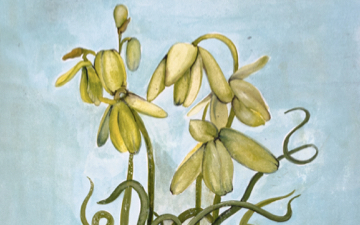Albuca is a genus of flowering plants in the family Asparagaceae, subfamily Scilloideae.[2] The genus is distributed mainly in southern and eastern Africa, with some species occurring in northern Africa and the Arabian Peninsula.[3] Plants of the genus are known commonly as slime lilies.[4]
These are perennial herbs growing from bulbs. The stem is sheathed in leaves with linear to strap-shaped blades.[5] They can be 8 centimeters to well over one meter long and are flat or keeled. They are generally fleshy and sappy with a mucilaginous juice that inspired the common name “slime lilies”.[6] The flowers of some species are scented, especially at night. They are borne in racemes, usually slender, but flat-topped in some species. The flowers may be on stiff, or slender, nodding stalks,[6] held erect or drooping. The six tepals are white to yellow and each has a green or brown stripe down the center. The outer three tepals spread open, while the inner three are connivent, curving inward so that the tips meet.[5] There are six stamens, which have wings at the bases that wrap around the ovary at the center of the flower. Some species have six fertile stamens, and in others the outer stamens are staminodes which do not produce pollen.[4] The fruit is a rounded or oval three-lobed capsule containing shiny black seeds.[5]
The three inner tepals can be closed firmly, raising the question of how pollinators might reach the stigma inside to deposit pollen.[4] In a study of the interaction between pollinators and Albuca flowers, leafcutter bees were observed prying open the tepals and squeezing through to obtain the nectar inside. In the process, they left pollen on the tips of the tepals, where it absorbed fluid, germinated, and fertilized ovules. This was the first known case of flower petals performing the function of the stigma.[4]
(From Wikipedia, June 2021)




